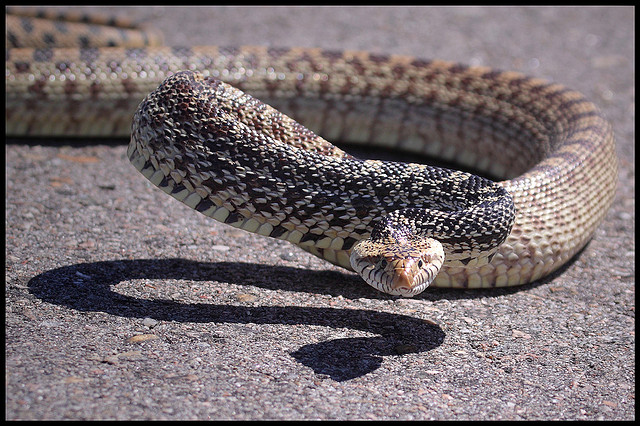snake is living over there
he needs to get some food somewhere
so he crosses the road to eat his dinner
snake goes back and forth you know
he loves his life like you do so
snake on the road
going home, going home
snake on the road
going home, going home
I know I guy with a twinkle in his eye
he likes the snakes
but he was not sure why
I said I think it’s because you have
snake atoms in your eye
snake on the road
going home, going home
snake on the road
going home, going home
so don’t drive too much
so the snakes can cross the road
and their homes won’t get too hot
from climate change yes it’s so
yeah don’t drive too much
study a little meteorology
you will it’s logical
to not drive so crazily
snake on the road
going home, going home
its true snakes are crossing the road
to get to home over there
and the less you drive
not only will not squash the snake
you will preserve the air too
so drive less to help the snake
because one day even you
will be a snake
snake on the road
going home, going home
so don’t too much
to save those snakes that are all going home
snake on the road
Snake On The Road / stele c12 improv
~~~~~~
Wikipedia excerpts: en.wikipedia.org/wiki/Roadkill
Roadkill is an animal or animals that have been struck and killed by motor vehicles.
A recent study showed that insects, too, are prone to a very high risk of roadkill incidence.
About 350,000 to 27 million birds are estimated to be killed on European roads each year.
In 1993, 25 schools throughout New England participated in a roadkill study involving 1,923 animal deaths. By category, the fatalities were:
81% mammals
15% birds
3% reptiles and amphibians
1% indiscernible
Extrapolating these data nationwide, Merritt Clifton, editor of Animal People Newspaper estimated that the following animals are being killed by motor vehicles in the United States annually: 41 million squirrels, 26 million cats, 22 million rats, 19 million opossums, 15 million raccoons, 6 million dogs, 350,000 deer
Since 2009, statewide roadkill observation systems have sprung up, enrolling hundreds of observers in reporting roadkill on a website. The observers, who are usually naturalists or professional scientists, provide identification, location, and other information about the observations.
The first wildlife roadkill identification guide produced by a state agency in North America was published by the British Columbia Ministry of Transportation (BCMoT) in Canada in 2008.[10] BCMoT’s “Wildlife Roadkill Identification Guide” focused on the most common large carnivores and ungulates found in British Columbia. The guide was developed to assist BCMoT’s maintenance contractors in identifying wildlife carcasses found on provincial highways as part of their responsibilities for BCMoT’s Wildlife Accident Reporting System (WARS).
In 1994, Michigan reported 56,666 deer collisions, of which five resulted in human fatalities, according to Mark Matthew Braunstein of the Santa Cruz Hub. The problem is so pervasive that, according to an article by Hank Pellissier of the San Francisco Chronicle, Michigan uses roadkill statistics to estimate its deer population.
Although strikes can happen at any time of day, deer tend to move at dawn and dusk, and are particularly active during the October–December mating season. Driving at night presents its own challenges: nocturnal species are on the move, and visibility, particularly side visibility, is reduced. When headlights approach a nocturnal animal, this makes it hard for the creature to see the approaching car (nocturnal animals see better in low than in bright light). Furthermore, the glare of vehicle headlights can dazzle some species, such as rabbits; they will freeze in the road rather than flee. The simple tactics of reducing speed and scanning both sides of the road for foraging deer can improve driver safety at night. Drivers may see the glow of a deer’s eyes before seeing the animal itself.
Wildlife crossings allow animals to travel over or underneath roads. They are most widely used in Europe, but have also been installed in a few U.S. locations and in parts of Western Canada. As new highways cause habitats to become increasingly fragmented, these crossings could play a crucial role in protecting endangered species. wildlifecrossing.net/california wildlifecrossing.net/maine
After Life – an exhibition and essay by artist Claudia Terstappen on roadkill from Australia Map Road Kill in Ireland [www.biology.ie] – Map Road Kill in Ireland
Driving Animals to Their Graves by Mark Matthew Braunstein, Santa Cruz Hub.
California Roadkill Observation System — for roadkill
Maine wildlife road watch system — for live and dead animal observations in Maine
The Art of Dead Mice by Hank Pellissier, San Francisco Chronicle.
Dr. Splatt’s Roadside Attraction, Melissa Kaplan’s Herp Care Collection.
Just Because It’s In Slow Motion Doesn’t Mean You Can Stop It – Joy Hunsberger—an artist who has been photographing roadkill as a form of ancestor worship since 1997.
Caught in the Headlights—a documentary film that examines the conflict between wildlife and automobile culture
Stop Roadkill—an artist using roadkill in art
Roadkill eating artist draws and paints colorful roadkill inspired icons / Fritz Art @ Pigeon Press
Lake Jackson Ecopassage is a campaign to mitigate roadkill along the world’s worst turtle-killing highway / lakejacksonturtles .org
Save The Alabama Red-bellied Turtle—a campaign to stop the killing of endangered Alabama Red-bellied Turtles along US 90
Snakes on road:
flickr.com/photos/8501482@N02/2618793650/
flickr.com/photos/craiglesliehodges/3235691624/
flickr.com/photos/drooo/5927280516/
flickr.com/photos/33246833@N00/1151846497/
~~~~~~
Musicians :: Record this song and we’ll add it here, and maybe on our home page or environmental songs page.
Artists :: Do a video, art, dance or media for this song and we’ll add it here, and maybe on our home page or environmental songs page.
Fans :: Donate $1 or more to sponsor a better version or recording of this song. Donate $44 or more to get a shared copyright certificate for this song or your choice of one of our other environmental songs.


Leave a Reply
You must be logged in to post a comment.